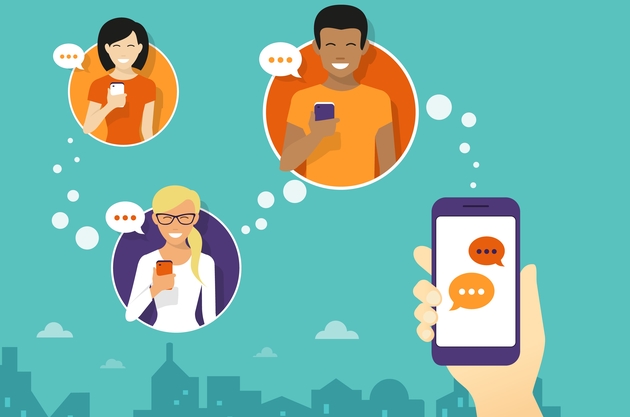Messaging apps and their marketing benefits

Grab your phone and look at the screen.
Now, count how many messaging apps you currently have on your phone. The chances are very good you have at least one and as many as five or six.
Can you say the same for any other type of app?
Do you have five fantasy football apps? Three music players? Four image editors?
It goes to show you just how important messaging apps have become in our daily lives. And, when you take into account the potential of the newest trend in messaging — chatbots — there’s no doubt you’re going to be seeing a lot more of them in your day.
In this post, we’re going to take a quick jaunt through the history of messenger apps. Then, we’ll see where they are going next, what the big names are doing about the growth of messaging, and why these apps are looking to integrate with artificial intelligence (AI), especially via voice activation, in the near future.
But first, ready to take a trip down memory lane?
A Quick History of Messaging
I remember my first encounter with a messaging app back in the mid to late ’90s. A good friend of mine worked at AOL and he sent me an email with a link to download a chat tool. A couple of minutes later I was chatting with him via my PC. Amazing!!
This was AIM, then known as AOL Instant Messenger. It was followed by MSN Messenger and Yahoo Messenger shortly thereafter.
Even though technically, messaging had been around for a while, at the time it felt quite revolutionary. You could chat with anyone anytime no matter where they were in the world. Messaging was so popular, a 2004 Pew study found that 53 million Americans were using instant messengers on their home, school, and work computers.
As technology advanced, so did messaging. And messaging wasn’t just for personal use, either. Businesses have also been able to get on these apps and improve their communication channels, not only inside the company but also with customers and clients.
When the mid-2000s hit, the messaging options exploded. Blackberry had their messenger service (BBM), Apple had introduced iChat in 2002, Skype arrived in 2003, and Google Talk (aka GChat) in 2005.
And then came the social networks. It wasn’t Facebook who started the messenger revolution in 2008 with Facebook Chat, it was actually MySpace that was the first social network to feature chat.
Some like to refer to this as the ‘first wave’ of chat technology. It paved the way for the current messaging options we have today. While Skype is still around, advancements have made Facebook Messenger, WhatsApp, WeChat, Viber, and Snapchat pretty much automatic downloads on most people’s mobile devices around the world.
Now, messenger apps are expanding even further, including AI-influenced chatbots most of which have been designed for personal use. But brands are now jumping into them because they see the potential for working with customers.
So it’s not completely surprising that a coming ‘wave’ is going to focus on AI. The thing to keep in mind is that this isn’t something that’s just taking hold. Integrating artificial intelligence has been something tech giants have wanted to do for decades.
From Larry Page in 2000:
“Artificial intelligence would be the ultimate version of Google. The ultimate search engine that would understand everything on the Web. It would understand exactly what you wanted, and it would give you the right thing.
It’s clear that messaging, voice-activation, and chatbots are important parts of the path to knowledge availability that many of the tech companies are striving for.
Messenger Apps Take Over the World
So that brings us to today. Where messenger apps are absolutely exploding.
This chart from Statista highlights the monthly users of a number of different messaging platforms with worldwide popularity (Note: It doesn’t include some messaging apps that are popular on the business side like HipChat, Slack, and Google Hangouts).
WhatsApp leads the way with over 1 billion monthly users. It’s quickly followed by Facebook Messenger with 900 million users. Chinese powerhouses QQ and WeChat come in third and fourth, respectively.
A recent study by TNS found that 55% of the population of the planet (you read that right) use a messenger app every single day. Just focus on Asia and the numbers grow even more, with 69% of users in China, and 73% in Hong Kong using them daily.
Also worth noting is that as of the middle of 2015, the ‘big 4’ messaging apps now surpass the biggest social networks in monthly active users. It shouldn’t come as a big surprise that mobile apps are becoming more popular, since according to comScore, mobile usage surpassed desktop around 2014.
It’s not simply a messenger app. Users can take out microloans, send friends money, buy from over 10 million merchants, play games, broadcast images like an Instagram account, order dinner, and even play the lottery, just to name a few.
Users love it because they can get virtually everything they need to do in both their personal and professional lives done with one app.
This is the basis of the future of messaging.
Snapchat
The other big messenger app that is making waves in the US is Snapchat. As of September 2016, Snapchat had over 150 million daily active users. Not only that, but users spend approximately 30 minutes per day on the app, with 60% of users spending their time creating new content.
Those are mind-blowing numbers, and it’s no wonder Facebook was desperate to buy in with their $3 billion offer. Right now, Snapchat is valued at approximately $20-25 billion dollars.
Snap, Inc. has been able to excel in creating a creative and ever evolving messenger app where a lot of other brands have failed. Now, users can not only send images but also use filters, geotagging, and send money to friends via Snapcash.
And with the recent release of Spectacles, Snap, Inc. looks like it’s the brand to conquer wearable glasses where Google failed, bringing yet another level to the messaging experience.
Facebook Goes All In
We can already see Facebook trying to do something similar with its messaging app. Note that Facebook bought WhatsApp for $19 billion in early 2014. And they tried to buy Snapchat in late 2013 for a rumored $3 billion in cash.
Right now, Facebook is trying to grab the youth market.
The reason for this is because younger users (the 13-24 crowd) are far more into messaging apps than social media or social networking sites. It’s one of the main factors behind why these apps are seeing such growth.
In fact, the trend lines are showing that messaging apps now grow faster than social networks.
Right now, and into the future, Facebook is looking to turn Messenger into a full platform. Users are already able to utilize Messenger from both inside Facebook and via the app. Plus, they can send images, video, voice notes, files, and even cash over Messenger as well.
Of course, consumers aren’t the only people Facebook is trying to target. They are also going after brands with chatbots.
Chatbots
Chatbots are one area where messenger apps and artificial intelligence are starting to come together. For a quick and easy definition of a chatbot, use this:
In its most basic form (we’ll use basic as a relative term here), a chatbot is a form of artificial intelligence that, combined with rules and algorithms, allow for a text-based chat interface to communicate with others. A chatbot is a tool that lets brands interact over chat with consumers.
Right now, Facebook claims they have about 33,000 chatbots operating inside Messenger. Messenger users can get a chatbot to do everything from asking for a weather report to call an Uber to order a Pizza. (You can see a list of about 40 right here).
Starting to sound a bit like WeChat, isn’t it?
The big draw for brands is the ability to offer education and customer service to consumers through chatbots. These bots can act as a front line customer service representative to consumers who want a simple question answered or a problem solved and don’t want to email or spend time on the phone.
This ties into what consumers want — more personalized service and a way to connect over messaging versus the phone.
The Marketing Benefits of Messaging Apps
We’ve seen that users, especially younger users of messaging apps, are all in when it comes to the product. Now, we’re also seeing how marketers are trying to reach those users through messaging beyond providing customer service.
While text messaging (also known as SMS) was thought to be a potential hotspot for marketers, text messaging is actually in decline around the world. The numbers track pretty well with the rise of chat and messaging apps, which look like they are here to stay for the foreseeable future.
As users continue to be more and more attached to their phones, there are a number of benefits marketers can see from including messaging apps as part of their overall marketing strategy.
Audience Segmentation
With messenger apps, marketers can pull in an incredible amount of data to segment their users rather than showing the same sponsored content or ads to all.
Kik is one messaging app that uses big data to break their users down by demographics like age, gender, and location. They then promote their sponsored content based on that data. Using this method of targeting segmented users seems to be working, as Kik reported: “16 million consumers have swapped 500 million messages via sponsored bots.”
Brand Sponsored Content
Yup, even chatbots can have ads. Earlier in 2016, Facebook launched sponsored messaging and click to message trials to see how users responded to them. The goal is to interact with the ad then have the chatbot engage with the user gently pushing them towards the sale.
Snapchat takes a different approach allowing for sponsored or branded stories and lenses. For the 2016 Superbowl, Gatorade used a sponsored lens that mimicked a bucket of the drink being poured over users. This lens was used 165 million times in only two days.
Higher Engagement
Consumers are so used to being bombarded with ads that it takes something special for them to engage. Brands can use that to their advantage by offering more content that is personal and geared towards increasing interaction.
Brands like Sephora and H&M have been able to use chatbots via Kik and see 70% to 90% of users who chat with these bots complete quizzes. Sephora has also given chatters “Kik Points” that they can use to bid on special samples.
Final Thoughts
As of now, the future of messaging apps and AI looks extremely bright, especially for marketers. We’ll see if Facebook is able to continue its path of world domination and find a way to create a messenger used worldwide that eventually becomes connected to an AI assistant as well. So far, it appears that they’re on the right track.
We’re entering a new era of messaging, and it will be interesting to see which brands come out on top as those willing to adapt quickly to the new potential out there. It will be pretty exciting to see the new channels that emerge from these technologies.
___
by Tony Messer
source: SEJ

